
Contributed by Mike Smolinski


|
||||||
Laid down on 21 Aug 1944 at Camden, N.J., by the New York Shipbuilding Corp.; launched on 1 Sep 1945, and commissioned at the Philadelphia Naval Shipyard on 9 Feb 1947. Decommissioned on 15 Mar 1956. During her time in reserve, Wright was reclassified on 15 May 1959, an auxiliary aircraft transport, AVT-7. Recommissioned at Puget Sound on 11 May 1963 as a command ship, designated CC-2. Ultimately decommissioned on 27 May 1970, Wright departed Naval Inactive Ship Maintenance Facility, Norfolk Naval Shipyard, Portsmouth, VA, 5 Apr 1974, under tow of USS Edenton (ATS-1) for further transfer to INACTSHIPFAC Philadelphia, PA (thanks to Ron Reeves for the info).
FATE: Stricken from the Navy List on 1 Dec 1977, and sold by the Defense Reutilization and Marketing Service (DRMS) for scrapping on 1 Aug 1980.
| Click On Image
For Full Size Image |
Size | Image Description | Contributed
By And/Or Copyright |
|
|---|---|---|---|---|
| Name |
||||
 NS024951 |
40k | CVL-49 was named after the Wright brothers: Wilbur (1867-1912, right) and Orville (1871-1948, left), aviation pioneers who made the first sustained, controlled, powered airplane flight in history, near Kitty Hawk, North Carolina, December 17, 1903.
A previous ship had borne the name Wright:
|
Image courtesy of Wikipedia | |
| As a Light Aircraft Carrier, CVL-49 |
||||
NS024904 |
68k | The newly completed light aircraft carrier USS Wright (CVL-49) underway on 15 March 1947. She carried, fore to aft, an SP fighter-control radar, a surface search radar, an SR-2 for long-range air search, and on the stub mainmast, an SR air search radar plus radomes for the DBM radar direction-finding (countermeasures) system. In theory the combination of an SR-2 and an SR improved overall radar performance by employing two sets operating at different wavelengths. The empty platform on the stub mast appears to have been intended for a TDY jammer. Photo and text from U.S. Aircraft Carriers: An Illustrated Design History, by Norman Friedman. |
Original photo submitted by Green Creek Studios Larger copy submitted by Robert Hurst |
|
NS024904a |
100k | USS Wright (CVL-49) on 15 March 1947 off Philadelphia, one month after commissioning. A rare SR-4 antenna can be clearly seen on the aft mast outrigger; only a few examples of this radar were installed, for a short period just after the war. Photo USN. Photo and text from Aircraft Carriers of the U.S. Navy, by Stefan Terzibaschitsch. |
Robert Hurst | |
 NS024910 |
87k | USS Wright (CVL-49) photographed on 1 May 1947. Official U.S. Navy Photograph, now in the collections of the National Archives (# 80-G-195684). |
Naval History & Heritage Command, via Robert Hurst | |
 NS04020307 |
2.43M | "This 1949 photo taken from the endpapers of New York Shipbuilding's 50th anniversary book, shows Newton Creek at high tide. The view is to the southeast, toward Gloucester Heights. Yorkship Village (Fairview) is at the upper left, flanked by the North Branch and the wide tidal floodplain of the creek's main channel. A causeway bridge across the main channel links Yorkship Village's Collings Road with Gloucester at the upper right. A rail line (note the freight train) follows the west bank of the creek. Conspicuously missing from this image are the east end of the Walt Whitman Bridge, I-676, and the bridge interchange, all built in the late 1950s. Most of the tidal floodplain seen here was filled and the course of the North Branch was altered during construction. The mouth of Newton Creek is at the center right. A heavy cruiser or battleship is moored in the creek. Another capital ship occupies one of the open slipways. Portions of two light carriers can be seen in the wet slip at the lower left, adjacent to the covered slipways." "In the lower left of center of the photo are two CVL's afloat and fitting-out. I believe this to be the sisters USS Saipan (CVL-48) and USS Wright (CVL-49), the last two CVL's to be built. This being the case, the photo would have to have [been] taken in the time period between 1 Sep 45 (launch of CVL-49) and 14 Jul 46 (commissioning of CVL-48)." "The large vessel fitting out to the right of the carriers, afloat and under cover, appears to be an Alaska Class Large Cruiser. USS Hawaii (CB-3) was launched on 3 Nov 45, and construction photos show the fitting out of the vessel under cover." "The[re] is also what appears to be a Baltimore class heavy cruiser at the far right of the photo, in near-complete condition. USS Toledo (CA-133) was launched in May 1945, and commissioned 27 Oct 1946. In the early spring of 1946, this vessel may have been this far along in its fitting-out, to have reached the ship's condition of the photo, but that is only speculation, on my part." This is the fitting piers, covered ways, and Newton Creek shipways at New York Ship between 1945 and October 1946. At the open ways, Newark (CL-108) has been cleared, and New Haven and Buffalo (CL-110) remain un-worked. Toledo is in Newton Creek. Saipan and Wright are fitting out at left. |
Bill Fessenden John Chiquoine |
|
 NS024911 |
184k | Lieutenant James waves a Texas flag from the cockpit of his F6F Hellcat fighter, after landing on board USS Wright (CVL-49), about 9 August 1948. Collection of Fleet Admiral Chester W. Nimitz. Naval History & Heritage Command (NH&HC) photo, # NH 62399. |
NH&HC | |
 NS024973 |
979k | A United States Navy (USN) Vought F4U-5 Corsair (BuNo 121800, modex M-301) of Fighter Squadron (VF) 23 "Flashers" on the deck of the light aircraft carrier USS Wright (CVL-49), November 1948. USN photo. |
Robert Hurst Pieter Bakels |
|
 NS024978 |
321k | A snapshot of USS Wright (CVL-49) taken 27 September 1949. Location unknown. Harley Flowers from Mobile, USA. This file is licensed under the Creative Commons Attribution-Share Alike 2.0 Generic license. |
Robert Hurst | |
 NS024908 |
95k | Taken in 1949 or 1952 in New York. | © George Bartlett | |
 NS024915 |
142k | USS Wright (CVL-49) operating on training duty, with six SNJ Texan aircraft on deck lined up for takeoff, circa the later 1940s or early 1950s. The photo's original caption reads: "The stage is set for the final scene of Basic Training: the flight students will qualify six carrier landings in SNJ Texans and the curtain will descend on the graduation finale." Official U.S. Navy Photograph, from the collections of the Naval History & Heritage Command (# NH 97618). |
Naval History & Heritage Command | |
 NS024967 |
130k | SNJ Texan trying to recover aboard USS Wright (CVL-49)—note extended tailhook. This photo may be related to the picture above and to this series of images. |
Tommy Trampp | |
 NS024968 |
135k | Group of sailors aboard USS Wright (CVL-49), late 1940s–early 1950s. |
Tommy Trampp | |
 NS024969 |
98k | Group photo, USS Wright (CVL-49), late 1940s–early 1950s. |
Tommy Trampp | |
 NS024963 |
194k | USS Wright (CVL-49) at anchor, location and date (early to mid-1950s) unknown. |
Courtesy of Scott Koen & ussnewyork.com | |
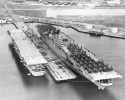 NS023230 |
1.40M | Carriers USS Wright (CVL-49) and USS Leyte (CV-32)—with Carrier Air Group (CVG) 3—moored at Naval Air Station (NAS) Quonset Point, Rhode Island, circa 1950. US Navy and Marine Corps Museum/Naval Aviation Museum, Photo No.1996.488.195.006. Robert L. Lawson Photograph Collection. |
Mike Green David Buell |
|
 NS024961 |
427k | Some photos of LCDR Robert D. Cosgrove's squadron, VS-822, on a two-week training duty from NAS New Orleans aboard USS Wright (CVL-49), in August 1950. ACDUTRA (ACtive DUty TRAining) aircrewmen after a mission. |
CDR Michael Cosgrove (Ret.), son of Robert D. Cosgrove | |
 NS024961a |
291k | ACDUTRA ceremony on Wright, 27 August 1950. |
||
 NS024961b |
177k | ACDUTRA Corsair landing on Wright. |
||
 NS024961c |
404k | ACDUTRA Corsair launching. |
||
 NS024961d |
271k | ACDUTRA Corsair ready to launch. |
||
 NS024961e |
268k | ACDUTRA loading rockets on Corsair. |
||
 NS024961f |
349k | ACDUTRA pilots on Corsair wing. |
||
 NS024961g |
280k | ACDUTRA ready room on Wright. |
||
 NS024961h |
582k | "LT William R. Jackson, Jr., left, executive officer, and LCDR Robert D. Cosgrove, commanding officer of Squadron VC 822, redesignated Squadron VS 822 by Chief of Naval Air Reserve Training, go over plans for their annual training duty aboard the local station, NAS Pensacola and aboard the carrier USS Wright." |
||
 NS024901 |
288k | Undated, probably taken in the early 1950s. |
John Spivey | |
 NS024905 |
213k | Starboard bow view of the Wright in an undated early 1950s Navy photo after having been converted to an ASW carrier. She carries a tall HF/DF mainmast, necessary for her new role. | © Green Creek Studios | |
 NS024906 |
439k | Undated image of the light aircraft carrier USS Wright (CVL-49) underway. The photo was probably taken in the early 1950s, when the ship had been fitted with tall HF/DF mainmasts and with the zenith-search derivative of the SG surface-search radar. Note too the SPS-6B, which did not enter service until about 1950, on the foremast. USN photo. Photo and text from U.S. Aircraft Carriers: An Illustrated Design History, by Norman Friedman. |
Robert Hurst | |
 NS024960 |
51k | USS Wright (CVL-49), location and date unknown but probably taken in the early 1950s (note tall mainmast and SPS-6B radar antenna on the foremast). Official U.S. Navy photo. U.S. National Archives, San Francisco. |
Tracy White, Researcher @ Large | |
 NS024925 |
39k | Observation/liaison plane landing and taking off. Probably taken in the early 1950s. | Edwin Kaukali | |
 NS024926 |
31k | |||
 NS024927 |
58k | Date and place unknown (probably taken in the early 1950s). | Edwin Kaukali | |
 NS024928 |
138k | With F2H Banshees of Experimental & Development Squadron VX-3 (tail code "XC") on deck. Location unknown; taken in the early 1950s. | Edwin Kaukali | |
 NS024924 |
244k | Undated. Probably taken in the early 1950s. | Edwin Kaukali | |
 NS024929 |
127k | |||
 NS024964 |
114k | With aircraft of three composite squadron detachments aboard, USS Wright (CVL-49) is underway circa 1951, on her first Mediterranean deployment. US Navy and Marine Corps Museum/Naval Aviation Museum, photo # 1988.179.003. |
Mike Green | |
 NS024962 |
105k | USS Wright (CVL-49) island structure, as seen from USS Cabot (CVL-28), during operations at Guantánamo Bay, Cuba, circa 1951–52. US Navy and Marine Corps Museum/Naval Aviation Museum, photo # 1992.025.003. |
Mike Green | |
 NS024970 |
197k | "In two ceremonies, one at 90 Church St. and the other aboard the Aircraft Carrier Wright, Rear Adm. Roscoe H. Hillenkoetter assumed command of the 3d Naval District and Rear Adm. Walter S. De Lany became the new commander of the Eastern Sea Frontier yesterday. About 250 officers and men witnessed the 13-minute ceremony in district headquarters in Church St. in which both admirals read their orders and exchanged farewell salutes. Adm. De Lany then reviewed the staff for the last time. Shortly afterward, on the Flight deck of the Wright at Pier 26, Beach St. and North River, Adm. De Lany took over the Frontier command from Vice Adm. Oscar C. Badger, who was retired a full admiral. About 400 officers and men watched Adm. De Lany's son, Lt. Walter S. Jr., help pin the three-star boards of a vice admiral to his father's shoulders." |
Leslie Lamers Brunner | |
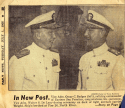 NS024970a |
924k | "In New Post. Vice Adm. Oscar C. Badger (left), retiring commander of Eastern Sea Frontier, congratulates his successor, Vice Adm. Walter S. De Lany during ceremony on deck of light aircraft carrier Wright. Ship's berthed at Pier 26, North River." Daily News, Tuesday, July 1, 1952. |
||
 NS024971 |
91k | As seen from HMS Vanguard (23), the photo is a starboard quarter view of USS Wright (CVL-49) and two Royal Navy aircraft carriers, HMS Illustrious (87) and HMS Eagle (R05), steaming in line ahead formation in the North Sea after leaving the Clyde. The carriers were participating in the September 1952 Operation Mainbrace. Wright has Chance-Vought Corsair aircraft ranged on her flight deck. Imperial War Museums photo, © IWM (A 32288). |
Mike Green | |
 NS024971a |
81k | As seen from HMS Vanguard (23), the photo shows a stern view of USS Wright (CVL-49) and two Royal Navy aircraft carriers, HMS Illustrious (87) and HMS Eagle (R05), steaming in line ahead formation in the North Sea after leaving the Clyde. The carriers were participating in the September 1952 Operation Mainbrace. Wright has Chance-Vought Corsair aircraft ranged on her flight deck. Eagle was leading the formation and is almost obscured by Illustrious. Imperial War Museums photo, © IWM (A 32285). |
||
 NS024976 |
424k | A U.S. Navy Grumman AF-2S Guardian of Anti-Submarine Squadron (VS) 31 "Topcats" is launched from the deck of USS Wright (CVL-49), circa 1953. National Naval Aviation Museum photo, # 1996.253.6224. |
Robert Hurst | |
 NS024912 |
527k | USS Wright (CVL-49) photographed circa the mid-1950s, with AD and F4U type aircraft parked on her flight deck. Official U.S. Navy Photograph, from the collections of the Naval History & Heritage Command (# NH 97615). Note that the ship has only three smokestacks, and the bow 40mm AA mounts have been landed. (From Aircraft Carriers of the U.S. Navy, by Stefan Terzibaschitsch, via Robert Hurst.) |
Naval History & Heritage Command Larger copy submitted by Robert Hurst |
|
 NS024913 |
197k | USS Wright (CVL-49) photographed circa the mid-1950s, with a deckload of AD Skyraider aircraft, automobiles and ship's boats. Official U.S. Navy Photograph, from the collections of the Naval History & Heritage Command (# NH 97616). |
Naval History & Heritage Command | |
 NS024914 |
106k | USS Wright (CVL-49) underway circa the mid-1950s, with about eighteen U.S. Marine Corps AD Skyraider aircraft parked on her flight deck. Official U.S. Navy Photograph, from the collections of the Naval History & Heritage Command (# NH 97617). |
Naval History & Heritage Command | |
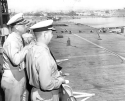 NS024975 |
514k | Three photos of USS Wright (CVL-49) in an inactivation overhaul at Mare Island in 1955. All photos were taken on 2 August 1955. NS024975: CAPT Thomas P. Wilson, right, skipper of Wright, and CDR Edwin T. Hughes, Executive Officer, watch from the bridge as Mare Island Naval Shipyard workers calk the carrier flight deck. NS024975a: Starboard bow aspect of carrier berth at Mare Island. NS024975b: Close-up of workers calking the flight deck. |
Darryl Baker | |
 NS024975a |
395k | |||
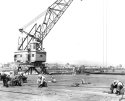 NS024975b |
483k | |||
| As a Command Ship, CC-2 |
||||
 NS024980 |
437k | USS Wright (CC-2) in dry dock, location and date unknown. |
Dale Hargrave | |
 NS024902 |
11k | (Small Image) Configured as Command ship (CC-2). |
USN | |
 NS024907 |
232k | The USS Wright (CC-2) as converted to a Command Ship. She was commissioned as CC-2 on May 11, 1963 as part of the National Emergency Command Post Afloat (NECPA) program. The converted Baltimore-class heavy cruiser USS Northampton (CA-125/CC-1) was her fleetmate in this program. The USS Saipan (CVL-48) had originally been slated for this duty and was in the initial stages of her conversion when she was redesignated as a Major Communications Relay Ship (AMGR-2). When the NECPA program was abandoned, the Wright was decommissioned, this occurring on May 27, 1970. She was stricken on December 1, 1977 and scrapped, this beginning in August, 1980. | © Green Creek Studios | |
 NS024909 |
87k | USS Wright (CC-2) underway, 17 June 1963. Note the extensive array of large communications antennas installed on the ship's former flight deck. Official U.S. Navy photograph, from the collections of the Naval History & Heritage Command, (# NH 97621). |
USN | |
 NS024917 |
82k | USS Wright (CC-2) underway, 17 June 1963, soon after she was converted to a command ship. The photo's lengthy original caption, explaining the ship's mission and features, read: "The command ship USS Wright (CC-2), one of the newest conceptions in command at sea, was commissioned in the spring of this year. The mission of the command ship is to provide command and control facilities which will contribute to the defense of the U.S. through the World wide communications facilities of the ship. The Wright has the most extensive communications facilities ever put aboard a ship. Its 'Voice of Command' can be heard by ships, aircraft, and stations throughout the World. Wright's command spaces have facilities for theatre-type presentations similar to command posts ashore, including projection equipment and huge motion picture screens. Overall, there are rooms for war operations, plotting, charts and graphics, emergency action, briefings and conferences. On the antenna deck are arranged the largest, most powerful transmitting antenna systems ever installed on a naval vessel. The largest of these antennae towers 114 feet above the deck. An entire room is given to the ship's teletype machines, each of which is capable of receiving incoming messages at the rate of 100 words per minute. The Wright is capable of handling as many messages in a day as many large shore-based communications stations." Official U.S. Navy photograph, from the collections of the Naval History and Heritage Command, # NH 97619. |
USN | |
 NS024918 |
114k | USS Wright (CC-2) underway, 17 June 1963, after conversion to a command ship. Official U.S. Navy photograph, from the collections of the Naval History and Heritage Command, # NH 97620. |
USN | |
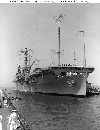 NS024921 |
82k | Arriving in San Diego in June 1963. | USN | |
 NS024919 |
96k | Underway, September 1963. | USN | |
 NS024920 |
115k | As above. | USN | |
 NS024920a |
98k | Another view of USS Wright (CC-2), apparently taken within minutes from the photo above. |
Courtesy of Scott Koen & ussnewyork.com | |
 NS024922 |
416k | USS Wright (CC-2) underway off the southern California coast, 25 September 1963, shortly after her conversion to a command ship. Note her extensive array of communications antennas and their associated masts. Official U.S. Navy photograph, catalog # KN-5885. |
Tommy Trampp | |
 NS024903 |
52k | Configured as Command Ship CC-2, Chesapeake Bay, July 1964. | © Richard Leonhardt | |
NS024966 |
886k | Plan of USS Wright (CC-2), as she appeared in her latter years. |
Dennis Miller, BMCS, USNR (Ret.) | |
 NS024974 |
83k | People's Republic of China Military Training. US Navy ship poster (wall chart) pertaining to USS Wright (CC-2), 1966. "Modification of 'Wright' class command ship." |
Tommy Trampp | |
 NS024977 |
261k | The crew of a U.S. Navy Kaman UH-2B Seasprite (BuNo 151316, modex HT-55) of Helicopter Combat Support Squadron (HC) 4 "Invaders" makes the 1000th landing aboard the command ship USS Wright (CC-2), circa 1966. |
Robert Hurst | |
 NS024923 |
53k | Stbd bow view taken 14 Oct 1966 in the VACAPES operating area. Photo by PH2 L.A. Bowders, USN, US Naval Air Station, Norfolk, VA. photo number 17235-10-66. | Gary Priolo | |
 NS024949 |
103k | USS Wright (CC-2) underway, location unknown, circa 1968. |
Courtesy of Scott Koen & ussnewyork.com | |
 NS024950 |
87k | From "All Hands" magazine, November 1968 edition. | Joe Radigan, MACM, USN, Ret. | |
 NS024952 |
27k | An aerial port side view of the crew manning the rails, 1968. | Karl Priest | |
 NS024953 |
103k | A 3/4 starboard view of the ship underway with some crew members on the A Deck, 1968. | Karl Priest | |
 NS024954 |
140k | After a cruise. | Karl Priest | |
 NS024955 |
103k | Berthing. | Karl Priest | |
 NS024956 |
77k | Entering NYC. | Karl Priest | |
 NS024957 |
84k | Evening at sea. | Karl Priest | |
 NS024958 |
27k | USS Guadalcanal (LPH-7) off bow. The photo was taken 8 May 1968, about 180 miles south of Norfolk. Scanned from the ship's magazine. | Karl Priest | |
 NS024959 |
117k | "The antenna deck looked a little like Madison Square Garden as the Wright-Guys witnessed several sparring contests at the May 'Smoker.'" Scanned from the ship's magazine. | Karl Priest | |
 NS024979 |
232k | Command ship USS Wright (CC-2) and the amphibious command ship USS Pocono (LCC-16) at Norfolk, Virginia, 5 April 1969. U.S. Navy photo from the USS John F. Kennedy (CVA-67) 1969 Cruise Book. |
Robert Hurst | |
 NS024916 |
86k | Jacket patch of the ship's insignia. Its design is based on the National shield, with an American eagle and globe in the lower right. The lightning bolt in the eagle's talons represents command and communications, Wright's mission. The motto "Vox Imperii" is translated "voice of the leaders." The original patch was received from USS Wright in 1970. U.S. Naval Historical Center Photograph (# NH 69468-KN). |
NHC | |
 NS024972 |
90k | USS Wright (CVL-49), matchbook cover. |
Leslie Lamers Brunner | |
|
||||
| Crew Contact and Reunion Information | ||||||||||||||||
|
| Related Links |
|
Hazegray & Underway World Aircraft Carrier Pages By Andrew Toppan. |
| Main Photo Index |
Aircraft Carrier Photo Index Page |
Auxiliary Aircraft Landing Training Ship (AVT) Photo Index Page |
Comments, Suggestions or Image submissions, E-mail Carrier Information
Problems and site related matters, E-mail Webmaster
This page was created by Paul Yarnall and is maintained by Fabio Peña
![]()
Last update: 29 March 2025